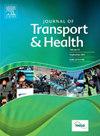Health in mobility planning: An assessment of how health is considered in Sustainable Urban Mobility Plans
IF 3.2
3区 工程技术
Q2 PUBLIC, ENVIRONMENTAL & OCCUPATIONAL HEALTH
引用次数: 0
Abstract
Introduction
Urban mobility can detrimentally impact city dwellers' health and quality of life, e.g. through air pollution, noise and traffic injuries, but offers opportunities for health promotion, e.g., through active travel. While the health impacts of transport are well known, the extent to which health is considered in mobility plans is less obvious. The European Commission encourages cities to develop Sustainable Urban Mobility Plans (SUMPs) to improve residents’ quality of life. We assess how health is addressed in SUMPs by examining: i) key health and health equity terminology, ii) explicit transport pathways to health, iii) health targets and key performance indicators, and iv) the health-rationale of actions and measures.
Methods
Using a customised health dictionary, we perform a quantitative text analysis of SUMPs issued from 2006 to 2023 (n = 230) from 31 European countries listed on the European Local Transport Information Service (Eltis) City Database. We further validate this by an in-depth qualitative analysis of a purposive sub-sample (n = 13).
Results
The findings show that while the prominence of health in SUMPs seems to be increasing, the link between transport and equity, and social and mental wellbeing is not frequently discussed. Detailed targets and KPIs for several health pathways are scarce or missing, as are the health rationale and health outcomes for proposed measures. Overwhelmingly SUMPs’ health aspirations focus on minimising detrimental health impacts of transport, primarily from traffic injuries and to a lesser extent from air pollution. Health related concepts such as accessibility and active travel feature prominently but are not explicitly identified as an opportunity to enhance health.
Conclusion
Urban mobility planning across Europe seems to miss an opportunity to embrace mobility as a driver of health promotion.
交通规划中的健康问题:对可持续城市交通规划中如何考虑健康问题的评估
导言城市交通会对城市居民的健康和生活质量造成不利影响,例如空气污染、噪音和交通伤害,但也为促进健康提供了机会,例如通过积极的出行方式。虽然交通对健康的影响众所周知,但在交通规划中对健康的考虑程度却不那么明显。欧盟委员会鼓励各城市制定可持续城市交通计划 (SUMP),以提高居民的生活质量。我们通过研究以下内容来评估可持续城市交通规划中如何解决健康问题:i) 关键的健康和健康公平术语;ii) 明确的健康交通途径;iii) 健康目标和关键绩效指标;iv) 行动和措施的健康理由。方法我们使用定制的健康字典,对欧洲地方交通信息服务(Eltis)城市数据库中列出的 31 个欧洲国家从 2006 年至 2023 年发布的可持续城市交通规划(n = 230)进行定量文本分析。结果研究结果表明,虽然健康问题在 SUMPs 中的重要性似乎在不断增加,但交通与公平、社会和精神健康之间的联系并没有得到经常性的讨论。一些健康途径的详细目标和关键绩效指标很少或缺失,拟议措施的健康理由和健康结果也是如此。绝大多数 SUMPs 对健康的期望都集中在尽量减少交通对健康的不利影响,主要是交通伤害,其次是空气污染。欧洲的城市交通规划似乎错失了将交通作为促进健康的动力的机会。
本文章由计算机程序翻译,如有差异,请以英文原文为准。
求助全文
约1分钟内获得全文
求助全文

 求助内容:
求助内容: 应助结果提醒方式:
应助结果提醒方式:


